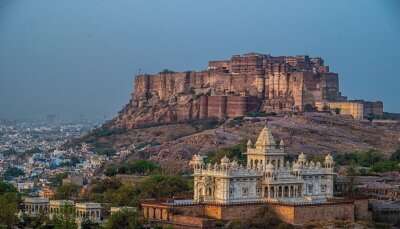Explore The Jaigarh Fort To Witness The History Of Rajput
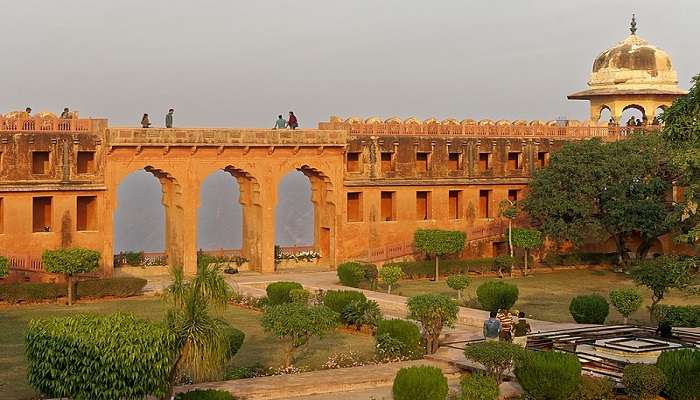
A fort depicting bespoke architecture, Jaigarh Fort in Jaipur, is a testament to the great Rajput rulers’ excellent acumen. Translating to Victory Fort, it was built to protect Amer Fort and its huge palace complex from enemies of the state. Jaigarh Fort was built by Mirza Raja Jai Singh in 1726. The king built it to be a defensive structure rather than a palace. The fort provides an excellent view of the Aravalli Range and Maota Lake and is built atop the Hill of Eagles, popularly called Cheel ka Teela.
History Of The Fort
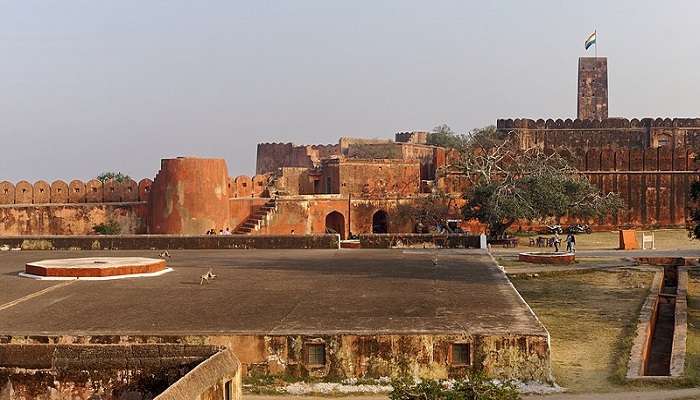
Amer was known in the ancient and mediaeval period as Dhundhar when the region was ruled by Meenas before the 10th century AD. What is known today as Jaigarh Fort was the primary defensive structure rather than the palace itself. The two structures are interconnected by encompassing fortifications and ruled by the Kachwahas from the 10th century onwards. The connected past of Amer and Jaigarh is incredulously owed to these rulers, as they propounded and set up their empire in Amer.
Jaigarh Fort in Jaipur was built by the senior most general (titled Mirza Raja) and a high-ranking mansabdar at the imperial court of the Mughal Empire and the ruler of the Kingdom of Amber (present-day Jaipur) King Jai Singh, in the year 1726. With an expansive and vastly spread outline overlooking Amer Fort, the fort layout symbolised vitality and royalty. It was planned to be built as a defensive structure, protecting Amer Fort rather than be a palace itself, by the king.
Must Read: Tourist Places In Jaipur
Architecture Of The Fort
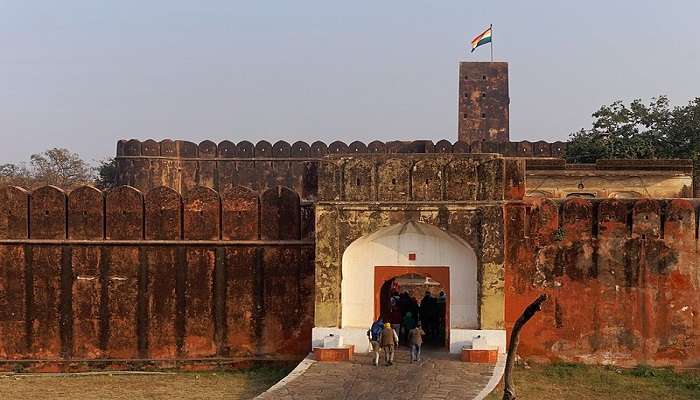
Jaigarh Fort was designed, conceptualised and intricately executed with perfection by the then architectural maestro, Vidyadhar. It was built to commemorate an aptly depict the rich cultural diversity and heritage of the city, which can be witnessed even today. This mammoth structure is truly a reflection of that glorious era of kings and queens adorned with their royal magnificence and grandeur.
The outlook of the fort, a first glimpse at the structure and you will instantly realize that this fort is also built with typical red sandstone which is the predominant material used in most, if not every single one of the Rajput and Mughal forts and palaces. The design is complimented with thick walls and intricate carvings while the entirety of the fort proudly talks about all the different phases of evolution that it has withstood, boasting of still standing strong today.
Features of Jaigarh Fort
This remarkable structure houses some of the most exquisite architectural gems, such as Aram Mandir, Lalit Mandir, Laxmi Vilas, and Vilas Mandir. Two additional ancient temples, the Ram Harihar, built in the 10th century, and the infamous Kal Bhairav temple, built in the 12th century, only add to the fort’s many existing attractions. The fort, along with all these diverse attractions, stands strong even today after witnessing one of the most tumultuous times in history. A visit here ensures pure delight to a history buff and an architecture student looking to explore the various chronicles of Rajput past chronicles.
1. Cannon Foundry
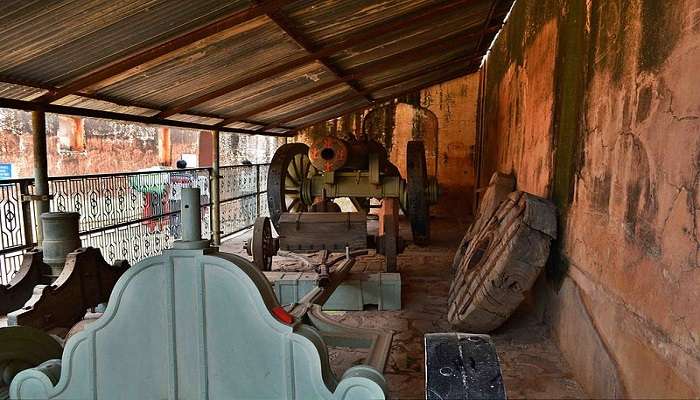
During the reign of the Mughal Emperor Shah Jahan, Jaigarh Fort came to be known as the world’s most efficient cannon foundry. It was mainly given this title because of the presence of massive iron ore mines located along the vicinity of the fort.
It was designated to be the main cannon foundry for the Mughal rulers. The cannon outpost was bravely protected during the many consecutive wars that broke out in the Mughal dynasty, owing to its military significance, until the protector Dara Shikoh was beaten in battle in 1658 and slain by his own brother Aurangzeb. The mastery of the wind tunnel designed for this cannon foundry ensured that it sucked in the hot air from outside to help in melting metal, transforming iron ore into the mighty cannons, with temperatures inside climbing to as high as a scary 2400 °F.
Suggested Read: Places to Visit In Rajasthan
2. Jaivana Cannon
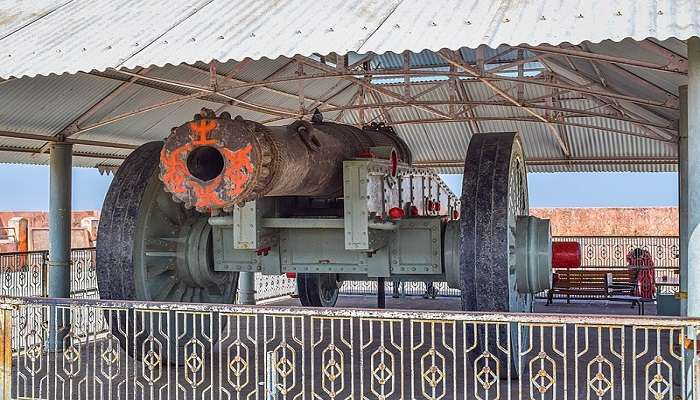
Amidst many accomplishments, Jaigarh Fort also stations the largest Cannon on Wheels, known as the Jaivana Cannon. It was masterfully assembled during the illustrious reign of Sawai Jai Singh II. It was originally manufactured in 1720 and still stands strong within the enclosure of the fort premises. The Jaivana was made during the reign of Maharaja Sawai Jai Singh II at a foundry in Jaigarh itself. The barrel stands at a mammoth 20.19 foot (6.15 m) in length and weighs a solid 50 tonnes. It has a diameter of an astounding 34.5 inches.
In addition to being an artillery heavyweight, the barrel has finely designed embellishments carved on it which depict a number of artworks like an elephant scroll, trees, and a pair of ducks or birds. The cannon is skillfully perched on wheels with the machinery of two back wheels mounted on roller pin bearings, all this to enable the cannon to turn 360° and fire in any direction necessary. Also, an aluminium-shed was erected to defend the cannon against difficult weather extremities. The cannon had a range of around 10 kilometres and used 50 kilograms (110 lb) balls.
3. Museum

The Fort houses a gorgeous museum preserving the lifestyle and societal structure of that period of Jaigarh Fort, with an effort to depict it as authentically as possible. The visitor can take a look at the stamps of the Royalty of Jaipur, along with a variety of other precious artefacts including the photographs, puppets and other war utilities. It is said to be the best opportunity to not only get a sneak-peak into the lives of the royals but experience the same.
The museum also contains a spittoon from the 15th century and a well-preserved circular pack of cards. If lucky, one can see the original hand-drawn blueprint or image of the fort and the palace within the museum premises.
Suggested Read: Forts In Rajasthan
Jaigarh Fort Timings
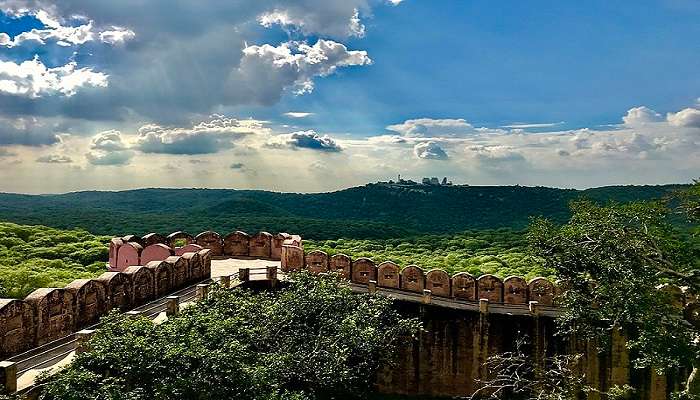
If you are planning to visit Jaipur and explore its various monuments, then the months of October to March are considered the most ideal time to visit Jaigarh Fort and other parts of the city. These months are relatively cooler, and you can enjoy walking around and exploring the historical diversity of the palaces and forts easily. It is much less stressful and tiring than the deadly hot summer months from April to September.
The Fort is open to the public from 9:00 a.m. to 4:30 p.m. daily. It is advisable to enter the fort only when you have at least 3 hours to spare, as that is the minimum time necessary to peacefully look around and take some good snapshots and aesthetically pleasing photographs.
Entry Fee
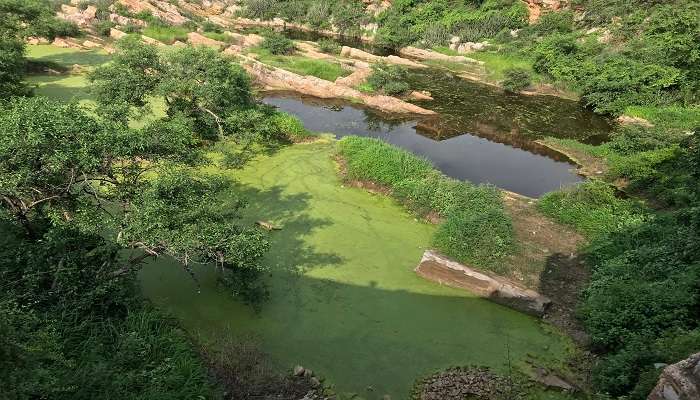
In order to enter the fort premises and explore the rich cultural remnants of our history, a nominal fee needs to be paid before getting your entry ticket:
Rs. 35 per person for Indian Tourists
Rs. 85 per person for Foreign Tourists
Rs. 50 if you wish to carry a Still Camera
Rs. 200 if you wish to carry a Video Camera
Further Read: Places To Visit In Murshidabad
Now that you have complete information about Jaigarh Fort and the surrounding monuments, you have a list of reasons to visit the pink city of Jaipur. Make sure you plan your trip to Jaipur as soon as possible and don’t forget to explore the Jaigarh Fort, historical marvels of this city. Don’t miss out on exploring these wonders; book your tickets now!
For our editorial codes of conduct and copyright disclaimer, please click here.
Cover Image Source: Jakub Hałun for Wikimedia Commons
Frequently Asked Questions About Jaigarh Fort
Who built the Jaigarh Fort?
Jaigarh Fort in Jaipur was built by the senior most general (titled Mirza Raja) and a high ranking mansabdar at the imperial court of Mughal Empire and the ruler of Kingdom of Amber (present-day Jaipur) King Jai Singh in the year 1726.
Can I still see the famous Jaivana Cannon?
Amidst many accomplishments, Jaigarh Fort also stations the largest Cannon on Wheels, known as the Jaivana Cannon. It was masterfully assembled during the illustrious reign of Sawai Jai Singh II. It was originally manufactured in 1720 and still stands strong within the enclosure of the fort premises.
Is entry free at the Jaigarh Fort?
No, the entry into the Jaigarh Fort is not free. In order to enter the fort premises and explore the rich cultural remnants of our history, a nominal fee needs to be paid before getting your entry ticket.
Is Amer Fort nearby?
Jaigarh fort is said to house multiple secret passages to help lead the rulers to safety, in case of any attack. It could guide the occupants to Amer Fort without being detected by enemies. Amer fort, by itself, is an architectural wonder that is famous for its multiple courtyards, huge entrances, swarming artworks on the walls and intricate stained-glass mirrors. The Sheesh Mahal is a striking feature of this Fort, located at a distance of around 500 metres from Jaigarh Fort.
Which movie was shot at these premises?
The picturesque location of Jaigarh Fort has attracted many prominent filmmakers to this site. Scenes from the Kangana Ranaut movie Manikarnika and Parineeta Chopra starrer Shudh Desi Romance, are few of the movies shot here at the Jaigarh fort.
People Also Read:
Mehrangarh Fort Red Fort Raghupur Fort

Passionate Marketing Student with a flair for storytelling, eagerly embarking on a journey within the vibrant world of travel. Excited to merge analytical acumen with creative skills to elevate the editorial landscape of the travel industry.





